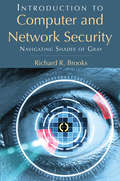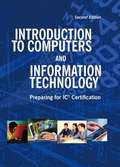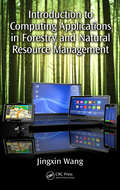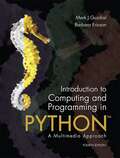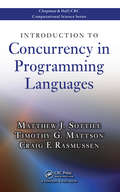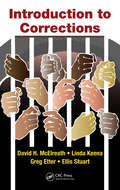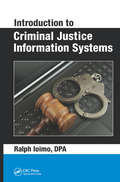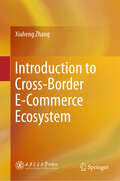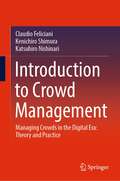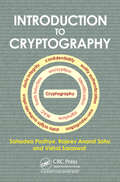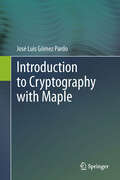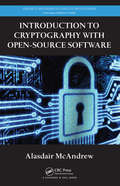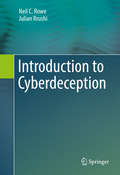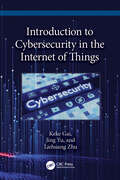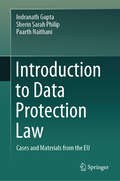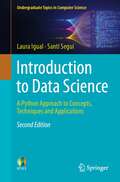- Table View
- List View
Introduction to Computer Networks and Cybersecurity
by Chwan-Hwa John WuIf a network is not secure, how valuable is it? Introduction to Computer Networks and Cybersecurity takes an integrated approach to networking and cybersecurity, highlighting the interconnections so that you quickly understand the complex design issues in modern networks. This full-color book uses a wealth of examples and illustrations to effective
Introduction to Computer Organization: ARM Edition
by Robert PlantzSee How the Magic Happens Built with ARM A64 Assembly LanguageThe ARM edition of Introduction to Computer Organization will show you how high-level code connects to computer hardware through ARM 64-bit assembly language. You&’ll learn ARM assembly language from the ground up, and all you&’ll need is some basic experience with programming. As you grow to understand ARM&’s 64-bit design (from first principles), you&’ll develop the skills to write more efficient, optimized code.Learn the fundamentals:Data storage formats and computer encodingBinary and hexadecimal arithmetic operationsBoolean algebra and logic gatesDigital circuit design Explore how software and hardware interact:Memory hierarchy, from CPU registers to the cloudCPU architecture and instruction executionARM 64-bit assembly language programming Get hands-on experience programming the GPIO on Raspberry Pi 3, 4, and 5 in assembly. Use GNU programming tools to examine code generated from C and C++ by the compiler, write assembly programs from scratch, and use the debugger to visualize execution, inspect registers, and understand machine-level operations. Each chapter includes practical &“Your Turn&” exercises to reinforce key concepts and build real-world programming skills.Whether you&’re optimizing code performance, developing embedded systems, or simply curious about how computers execute your programs, this guide provides deep insight into how software and hardware interact to bring programs to life.
Introduction to Computer Organization: An Under the Hood Look at Hardware and x86-64 Assembly
by Robert PlantzThis hands-on tutorial is a broad examination of how a modern computer works. Classroom tested for over a decade, it gives readers a firm understanding of how computers do what they do, covering essentials like data storage, logic gates and transistors, data types, the CPU, assembly, and machine code.Introduction to Computer Organization gives programmers a practical understanding of what happens in a computer when you execute your code. You may never have to write x86-64 assembly language or design hardware yourself, but knowing how the hardware and software works will give you greater control and confidence over your coding decisions. We start with high level fundamental concepts like memory organization, binary logic, and data types and then explore how they are implemented at the assembly language level.The goal isn&’t to make you an assembly programmer, but to help you comprehend what happens behind the scenes between running your program and seeing &“Hello World&” displayed on the screen. Classroom-tested for over a decade, this book will demystify topics like: • How to translate a high-level language code into assembly language • How the operating system manages hardware resources with exceptions and interrupts • How data is encoded in memory • How hardware switches handle decimal data • How program code gets transformed into machine code the computer understands • How pieces of hardware like the CPU, input/output, and memory interact to make the entire system workAuthor Robert Plantz takes a practical approach to the material, providing examples and exercises on every page, without sacrificing technical details. Learning how to think like a computer will help you write better programs, in any language, even if you never look at another line of assembly code again.
Introduction to Computer Security
by Roberto Tamassia Michael T. GoodrichThis book is intended to provide an introduction to general principles of computer security from an applied viewpoint, common cyberattacks, including viruses, worms, password crackers, keystroke loggers, denial-of-service, DNS cache poisoning, port scanning, spoofing, and phishing.
Introduction to Computer Systems for Health Information Technology (Second Edition)
by Nanette B. Sayles Kathy C. TrawickThe objectives of this book are: Describe the functions of the basic components of the personal computer to include hardware, software, networks, and Internet technologies; Identify and discuss the impact of computers in healthcare in all areas within a facility; Discuss the history of computers in healthcare; Compare and contrast the similarities and differences between the Internet, intranet, and extranet as used in healthcare.
Introduction to Computer and Network Security: Navigating Shades of Gray
by Richard R. BrooksGuides Students in Understanding the Interactions between Computing/Networking Technologies and Security Issues Taking an interactive, "learn-by-doing" approach to teaching, Introduction to Computer and Network Security: Navigating Shades of Gray gives you a clear course to teach the technical issues related to security. Unlike most computer securi
Introduction to Computers and Information Technology: Preparing for IC3 Certification (Second Edition)
by Prentice HallIntroduction to Computers and Information Technology teaches essential computer technology concepts and skills. This text helps students build a concrete understanding of how computers work and how various types of computing devices and accessories are used in school, work, and at home. The text covers objectives of IC3 GS5 and IC3 Spark standards.
Introduction to Computing Applications in Forestry and Natural Resource Management
by Jingxin WangDue to the complexity of operational forestry problems, computing applications are becoming pervasive in all aspects of forest and natural resource management. This book provides a comprehensive introduction to computers and their applications in forest and natural resource management and is designed for both undergraduate and graduate students in forestry and natural resources. It introduces state-of-the-art applications for several of the most important computer technologies in terms of data acquisition, data manipulation, basic programming techniques, and other related computer and Internet concepts and applications. This book consists of six parts and 19 chapters.
Introduction to Computing and Programming In Python: A Multimedia Approach
by Barbara Ericson Mark GuzdialThis book is a uniquely researched and up-to-date volume that is widely recognized for its successful introduction to the subject of Media Computation. Emphasizing creativity, classroom interaction, and in-class programming examples, the book takes a bold and unique approach to computation that engages students and applies the subject matter to the relevancy of digital media. <p><p> The Fourth Edition teaches students to program in an effort to communicate via social computing outlets, providing a unique approach that serves the interests of a broad range of students. Key Topics: Introduction to Computer Science and Media Computation; Introduction to Programming; Creating and Modifying Text; Modifying Pictures Using Loops; Picture Techniques with Selection; Modifying Pixels by Position; Modifying Sounds Using Loops; Modifying Samples in a Range; Making Sounds by Combining Pieces; Building Bigger Programs; Manipulating Text with Methods and Files; Advanced Text Techniques: Web and Information; Making Text for the Web; Creating and Modifying Movies; Speed; Functional Programming; Object Oriented Programming. <p><p> This book is useful for anyone interested in learning computer programming.
Introduction to Concurrency in Programming Languages
by Matthew J. Sottile Timothy G. Mattson Craig E RasmussenIllustrating the effect of concurrency on programs written in familiar languages, this text focuses on novel language abstractions that truly bring concurrency into the language and aid analysis and compilation tools in generating efficient, correct programs. It also explains the complexity involved in taking advantage of concurrency with regard to program correctness and performance. The book describes the historical development of current programming languages and the common threads that exist among them. It also contains several chapters on design patterns for parallel programming and includes quick reference guides to OpenMP, Erlang, and Cilk. Ancillary materials are available on the book's website.
Introduction to Corrections
by David H. McElreath Greg Etter Linda Keena Ellis Stuart Jr.Millions in our nation are under some type of judicial sanction, with some individuals behind bars but the majority serving their sentences while living and working among us. Introduction to Corrections examines predominant issues related to the system of administering to offenders in the United States. Written in a simple, concise style and enhanc
Introduction to Criminal Justice Information Systems
by Ralph IoimoThe proliferation of information systems throughout the criminal justice system has prompted many universities supporting criminal justice programs to add criminal justice information systems technology to their curriculums. Several universities have gone so far as to hire professors with specializations in information technology and to offer criminal justice information systems as an area of concentration. Introduction to Criminal Justice Information Systems gives an overview of the various software systems and technologies currently used in the criminal justice environment. The book covers a variety of topics critical to each member of the criminal justice system: police, prosecutor, courts, and corrections. It details the current systems in use, how they are used, and how separate systems interact with others. It also suggests how the current technology and the processes built upon it will evolve. While designed as a textbook to meet the needs of an introductory criminal justice information technology course, Introduction to Criminal Justice Information Systems is also a flexible resource useful to professionals in relevant areas of the criminal justice system. With rapidly increasing development and use of technology in modern law enforcement, this book provides a much-needed reference for those who are responsible for its implementation as well as an essential introduction to those who will become responsible for it. An instructor's manual is available as an electronic download upon request.
Introduction to Cross-Border E-Commerce Ecosystem
by Xiaheng ZhangThis book combines the current development status of cross-border e-commerce, proposes the theory of cross-border e-commerce ecosystem, and provides an overall interpretation of cross-border e-commerce from macro, meso, and micro perspectives around core elements. The topics involved in this book include cross-border e-commerce platforms, cross-border logistics, cross-border payments, marketing management, risk management, etc., almost covering the main links of cross-border e-commerce transaction activities, reflecting the cutting-edge trends of cross-border e-commerce at the current stage, and has important theoretical significance and practical value for promoting the development of global cross-border e-commerce. The translation was done with the help of artificial intelligence. A subsequent human revision was done primarily in terms of content.
Introduction to Crowd Management: Managing Crowds in the Digital Era: Theory and Practice
by Katsuhiro Nishinari Claudio Feliciani Kenichiro ShimuraThis book will guide you in a simple and illustrative way through all aspects related to crowd behaviour, including sociological theories, methods of crowd control, people detection and tracking, and crowd simulation and prediction, while examining previous accidents to learn from the past. Crowds are a constant presence in most cities around the globe and mass gatherings are attracting an increasing number of people. While experience can help manage large crowds and plan mass events, knowledge on crowd behaviour is fundamental for successfully dealing with unexpected situations, improving current practices and implementing state-of-the-art technologies in management strategies. After letting people laugh about the controversy on colliding pedestrians, with this book, two of the Ig Nobel laureates on pedestrian traffic will make you think (and learn) presenting through a collaborative approach, combining theoretical with practical advice, the science behind crowd dynamics and the importance it plays in our increasingly urbanized society. Fundamental aspects related to crowd management are presented using simple concepts requiring little or no knowledge of mathematics or engineering. Professionals involved in pedestrian traffic, as well as students and researchers entering the field of crowd dynamics, will find this book a useful interdisciplinary introduction on the subject, exploring both fundamental background information and more specific topics related to crowd management.
Introduction to Cryptography
by Vishal Saraswat Sahadeo Padhye Rajeev A. SahuElectronic communication and financial transactions have assumed massive proportions today. But they come with high risks. Achieving cyber security has become a top priority, and has become one of the most crucial areas of study and research in IT. This book introduces readers to perhaps the most effective tool in achieving a secure environment, i.e. cryptography. This book offers more solved examples than most books on the subject, it includes state of the art topics and discusses the scope of future research.
Introduction to Cryptography with Maple
by José Luis Gómez PardoThis introduction to cryptography employs a programming-oriented approach to study the most important cryptographic schemes in current use and the main cryptanalytic attacks against them. Discussion of the theoretical aspects, emphasizing precise security definitions based on methodological tools such as complexity and randomness, and of the mathematical aspects, with emphasis on number-theoretic algorithms and their applications to cryptography and cryptanalysis, is integrated with the programming approach, thus providing implementations of the algorithms and schemes as well as examples of realistic size. A distinctive feature of the author's approach is the use of Maple as a programming environment in which not just the cryptographic primitives but also the most important cryptographic schemes are implemented following the recommendations of standards bodies such as NIST, with many of the known cryptanalytic attacks implemented as well. The purpose of the Maple implementations is to let the reader experiment and learn, and for this reason the author includes numerous examples. The book discusses important recent subjects such as homomorphic encryption, identity-based cryptography and elliptic curve cryptography. The algorithms and schemes which are treated in detail and implemented in Maple include AES and modes of operation, CMAC, GCM/GMAC, SHA-256, HMAC, RSA, Rabin, Elgamal, Paillier, Cocks IBE, DSA and ECDSA. In addition, some recently introduced schemes enjoying strong security properties, such as RSA-OAEP, Rabin-SAEP, Cramer--Shoup, and PSS, are also discussed and implemented. On the cryptanalysis side, Maple implementations and examples are used to discuss many important algorithms, including birthday and man-in-the-middle attacks, integer factorization algorithms such as Pollard's rho and the quadratic sieve, and discrete log algorithms such as baby-step giant-step, Pollard's rho, Pohlig--Hellman and the index calculus method. This textbook is suitable for advanced undergraduate and graduate students of computer science, engineering and mathematics, satisfying the requirements of various types of courses: a basic introductory course; a theoretically oriented course whose focus is on the precise definition of security concepts and on cryptographic schemes with reductionist security proofs; a practice-oriented course requiring little mathematical background and with an emphasis on applications; or a mathematically advanced course addressed to students with a stronger mathematical background. The main prerequisite is a basic knowledge of linear algebra and elementary calculus, and while some knowledge of probability and abstract algebra would be helpful, it is not essential because the book includes the necessary background from these subjects and, furthermore, explores the number-theoretic material in detail. The book is also a comprehensive reference and is suitable for self-study by practitioners and programmers.
Introduction to Cryptography with Open-Source Software (Discrete Mathematics and Its Applications)
by Alasdair McAndrewOnce the privilege of a secret few, cryptography is now taught at universities around the world. Introduction to Cryptography with Open-Source Software illustrates algorithms and cryptosystems using examples and the open-source computer algebra system of Sage. The author, a noted educator in the field, provides a highly practical learning experienc
Introduction to Cyberdeception
by Neil C. Rowe Julian RrushiThis book is an introduction to both offensive and defensive techniques of cyberdeception. Unlike most books on cyberdeception, this book focuses on methods rather than detection. It treats cyberdeception techniques that are current, novel, and practical, and that go well beyond traditional honeypots. It contains features friendly for classroom use: (1) minimal use of programming details and mathematics, (2) modular chapters that can be covered in many orders, (3) exercises with each chapter, and (4) an extensive reference list. Cyberattacks have grown serious enough that understanding and using deception is essential to safe operation in cyberspace. The deception techniques covered are impersonation, delays, fakes, camouflage, false excuses, and social engineering. Special attention is devoted to cyberdeception in industrial control systems and within operating systems. This material is supported by a detailed discussion of how to plan deceptions and calculate their detectability and effectiveness. Some of the chapters provide further technical details of specific deception techniques and their application. Cyberdeception can be conducted ethically and efficiently when necessary by following a few basic principles. This book is intended for advanced undergraduate students and graduate students, as well as computer professionals learning on their own. It will be especially useful for anyone who helps run important and essential computer systems such as critical-infrastructure and military systems.
Introduction to Cybersecurity in the Internet of Things
by Jing Yu Liehuang Zhu Keke GaiThis book addresses the security challenges facing the rapidly growing Internet of Things (IoT) industry, including the potential threats and risks arising from its complex architecture.The authors discuss the overall IoT architecture, covering networking, computing, and security threats and risks to hardware such as sensors, actuators, and portable devices, as well as infrastructure layers. They cover a range of technical concepts such as cryptography, distributed storage, and data transmission, and offer practical advice on implementing security solutions such as authentication and access control.By exploring the future of cybersecurity in the IoT industry, with insights into the importance of big data and the threats posed by data mining techniques, this book is an essential resource for anyone interested in, or working in, the rapidly evolving field of IoT security.
Introduction to Data Analysis and Graphical Presentation in Biostatistics with R
by Thomas W. MacfarlandThrough real-world datasets, this book shows the reader how to work with material in biostatistics using the open source software R. These include tools that are critical to dealing with missing data, which is a pressing scientific issue for those engaged in biostatistics. Readers will be equipped to run analyses and make graphical presentations based on the sample dataset and their own data. The hands-on approach will benefit students and ensure the accessibility of this book for readers with a basic understanding of R. Topics include: an introduction to Biostatistics and R, data exploration, descriptive statistics and measures of central tendency, t-Test for independent samples, t-Test for matched pairs, ANOVA, correlation and linear regression, and advice for future work.
Introduction to Data Governance for Machine Learning Systems: Fundamental Principles, Critical Practices, and Future Trends
by Aditya Nandan PrasadThis book is the first comprehensive guide to the intersection of data governance and machine learning (ML) projects. As ML applications proliferate, the quality, reliability, and ethical use of data is central to their success, which gives ML data governance unprecedented significance. However, adapting data governance principles to ML systems presents unique, complex challenges. Author Aditya Nandan Prasad equips you with the knowledge and tools needed to navigate this dynamic landscape effectively. Through this guide, you will learn to implement robust and responsible data governance practices, ensuring the development of sustainable, ethical, and future-proofed AI applications. The book begins by covering fundamental principles and practices of underlying ML applications and data governance before diving into the unique challenges and opportunities at play when adapting data governance theory and practice to ML projects, including establishing governance frameworks, ensuring data quality and interpretability, preprocessing, and the ethical implications of ML algorithms and techniques, from mitigating bias in AI systems to the importance of transparency in models. Monitoring and maintaining ML systems performance is also covered in detail, along with regulatory compliance and risk management considerations. Moreover, the book explores strategies for fostering a data-driven culture within organizations and offers guidance on change management to ensure successful adoption of data governance initiatives. Looking ahead, the book examines future trends and emerging challenges in ML data governance, such as Explainable AI (XAI) and the increasing complexity of data. What You Will Learn Comprehensive understanding of machine learning and data governance, including fundamental principles, critical practices, and emerging challenges Navigating the complexities of managing data effectively within the context of machine learning projects Practical strategies and best practices for implementing effective data governance in machine learning projects Key aspects such as data quality, privacy, security, and ethical considerations, ensuring responsible and effective use of data Preparation for the evolving landscape of ML data governance with a focus on future trends and emerging challenges in the rapidly evolving field of AI and machine learning Who This Book Is For Data professionals, including data scientists, data engineers, AI developers, or data governance specialists, as well as managers or decision makers looking to implement or improve data governance practices for machine learning projects
Introduction to Data Protection Law: Cases and Materials from the EU
by Indranath Gupta Sherin Sarah Philip Paarth NaithaniThis textbook considers cases and materials introducing European Union (EU) data protection law to data protection enthusiasts while acting as a reference point for students and practitioners. The book's utility is twofold: the cases and materials can be used as a textbook as well as reference point for research. The book will benefit individuals new to this area and those at an intermediate level of familiarity with data protection law. It includes judgements delivered by the Court of Justice of the European Union (CJEU)/ European Court of Justice (ECJ) and decisions delivered by Data Protection Authorities (DPA) in the EU. While providing an overview of data protection law in the EU, the book introduces basic concepts of data protection law, principles of data protection law and rights and duties and remedies under the data protection law. Students would greatly benefit from the book by using it as an introduction to data protection law and as a reference point for research and assessments. Course instructors would benefit from the book by using it as core reading material.
Introduction to Data Science
by Laura Igual Santi SeguíThis accessible and classroom-tested textbook/reference presents an introduction to the fundamentals of the emerging and interdisciplinary field of data science. The coverage spans key concepts adopted from statistics and machine learning, useful techniques for graph analysis and parallel programming, and the practical application of data science for such tasks as building recommender systems or performing sentiment analysis. Topics and features: provides numerous practical case studies using real-world data throughout the book; supports understanding through hands-on experience of solving data science problems using Python; describes techniques and tools for statistical analysis, machine learning, graph analysis, and parallel programming; reviews a range of applications of data science, including recommender systems and sentiment analysis of text data; provides supplementary code resources and data at an associated website.
Introduction to Data Science in Biostatistics: Using R, the Tidyverse Ecosystem, and APIs
by Thomas W. MacFarlandIntroduction to Data Science in Biostatistics: Using R, the Tidyverse Ecosystem, and APIs defines and explores the term "data science" and discusses the many professional skills and competencies affiliated with the industry. With data science being a leading indicator of interest in STEM fields, the text also investigates this ongoing growth of demand in these spaces, with the goal of providing readers who are entering the professional world with foundational knowledge of required skills, job trends, and salary expectations. The text provides a historical overview of computing and the field's progression to R as it exists today, including the multitude of packages and functions associated with both Base R and the tidyverse ecosystem. Readers will learn how to use R to work with real data, as well as how to communicate results to external stakeholders. A distinguishing feature of this text is its emphasis on the emerging use of APIs to obtain data.
Introduction to Data Science: A Python Approach to Concepts, Techniques and Applications (Undergraduate Topics in Computer Science)
by Laura Igual Santi SeguíThis accessible and classroom-tested textbook/reference presents an introduction to the fundamentals of the interdisciplinary field of data science. The coverage spans key concepts from statistics, machine/deep learning and responsible data science, useful techniques for network analysis and natural language processing, and practical applications of data science such as recommender systems or sentiment analysis. Topics and features: Provides numerous practical case studies using real-world data throughout the book Supports understanding through hands-on experience of solving data science problems using Python Describes concepts, techniques and tools for statistical analysis, machine learning, graph analysis, natural language processing, deep learning and responsible data scienceReviews a range of applications of data science, including recommender systems and sentiment analysis of text data Provides supplementary code resources and data at an associated website This practically-focused textbook provides an ideal introduction to the field for upper-tier undergraduate and beginning graduate students from computer science, mathematics, statistics, and other technical disciplines. The work is also eminently suitable for professionals on continuous education short courses, and to researchers following self-study courses.





